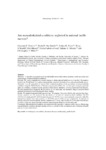Mostrar o rexistro simple do ítem
Are musculoskeletal conditions neglected in national health surveys?
| dc.contributor.author | Ferreira, Giovanni E. | |
| dc.contributor.author | Buchbinder, Rachelle | |
| dc.contributor.author | Zadro, Joshua R. | |
| dc.contributor.author | O´Keeffe, Mary | |
| dc.contributor.author | Kharel, Priti | |
| dc.contributor.author | Carballo-Costa, Lidia | |
| dc.contributor.author | Oliveira, Juliana S. | |
| dc.contributor.author | Maher, Christopher G. | |
| dc.date.accessioned | 2021-10-25T09:21:01Z | |
| dc.date.available | 2021-10-25T09:21:01Z | |
| dc.date.issued | 2021-01-26 | |
| dc.identifier.citation | Ferreira GE, Buchbinder R, Zadro JR, O'Keeffe M, Kharel P, Carballo-Costa L, Oliveira JS, Maher CG. Are musculoskeletal conditions neglected in national health surveys? Rheumatology (Oxford). 2021 Oct 2;60(10):4874-4879. | es_ES |
| dc.identifier.issn | 1462-0324 | |
| dc.identifier.uri | http://hdl.handle.net/2183/28712 | |
| dc.description | Concise report | es_ES |
| dc.description.abstract | [Abstract] Objective: To describe the proportion of national health surveys that contain questions on the prevalence and consequences of musculoskeletal conditions. Methods: We used a comprehensive search strategy to obtain national health surveys from the 218 countries listed by the World Bank. Two authors independently extracted information from each national health survey. Outcomes were the proportion of surveys that contained questions on the prevalence of musculoskeletal conditions using the Global Burden of Disease categorization of RA, OA, low back pain, neck pain, gout and other and contained condition-specific questions about activity limitation, severity of pain and work absence. We also measured how frequently the prevalence of low back pain was measured using a consensus-based standard definition for low back pain prevalence studies. Results: We identified national health surveys from 170 countries. Sixty-two (36.4%), the majority from high-income countries (n = 43), measured the prevalence of at least one musculoskeletal condition. OA [53 (85.4%)], low back pain [39 (62.9%)] and neck pain [37 (59.7%)] were most commonly measured, while RA and gout prevalence were only measured in 10 (5.9%) and 3 (1.8%) surveys, respectively. A minority of surveys assessed condition-specific activity limitations [6 (3.6%)], pain severity [5 (2.9%)] and work absence [1 (0.6%)]. Only one survey used the consensus-based standard definition for low back pain. Conclusion: Musculoskeletal conditions are neglected in the majority of national health surveys. Monitoring musculoskeletal conditions through ongoing surveys is crucial for the development and evaluation of health policies to reduce their burden. | es_ES |
| dc.language.iso | eng | es_ES |
| dc.publisher | Oxford University Press | es_ES |
| dc.relation.uri | https://doi.org/10.1093/rheumatology/keab025 | es_ES |
| dc.subject | Health policy | es_ES |
| dc.subject | Low back pain | es_ES |
| dc.subject | Osteoarthritis | es_ES |
| dc.subject | Public health | es_ES |
| dc.subject | Rheumatic diseases | es_ES |
| dc.title | Are musculoskeletal conditions neglected in national health surveys? | es_ES |
| dc.type | info:eu-repo/semantics/article | es_ES |
| dc.rights.access | info:eu-repo/semantics/openAccess | es_ES |
| UDC.journalTitle | Rheumatology | es_ES |
| UDC.volume | 60 | es_ES |
| UDC.issue | 10 | es_ES |
| UDC.startPage | 4874 | es_ES |
| UDC.endPage | 4879 | es_ES |
Ficheiros no ítem
Este ítem aparece na(s) seguinte(s) colección(s)
-
GI-IPRF - Artigos [144]






